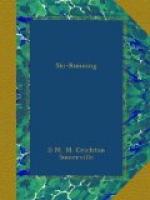On a long and dangerous tour the safety of the party may ultimately depend upon the trust and confidence placed in the Guide in charge, and by him in his clients, and this should be remembered in all negotiations. These men often have to risk their lives for the sake of the people who employ them, and their staunch unselfishness is a fine example of human endeavour for the benefit of others. Their fees may appear to be high, but when everything is taken into consideration, including the shortness of their Winter and Summer Seasons, it is soon realized that the fees are not exorbitant.
MAPS AND FINDING THE WAY
Every Ski runner going across country should carry a map. Even on a short run a great deal can be learnt from a map, which will prove useful later on a longer run. Both time and risk can be saved by people who run by their map and who know how to avoid dangerous places and how to take advantage of narrow safe openings.
There are different types of maps to be had in Switzerland. The best are the official Ordnance Maps published by the Eidg. Landestopographie at Bern. The mountain districts are produced at a scale of 1 centimetre in 50,000 centimetres or 2 centimetres in one kilometre, and large or small sheets can be bought almost everywhere. The gradients are clearly shown by contour lines. The equidistance being 30 metres, or roughly 100 feet, the dotted contour lines when height is marked some every 8 or 10 ordinary contour lines. This differs according to the edition. Cliff and rock are shown grey, while glacier contour lines are blue.
Some districts, such as the Bernese Oberland, have produced this map with red lines showing all the Ski runs. In other places they also provide Ski-ing maps, but on a different scale and not as good as the Ordnance Map.
All maps are best when mounted on linen, as the weathering they receive on a run may reduce a paper map to pulp or rag.
It is easy to work out the distance of runs or the gradient of slopes from the large scale Ordnance Map. 1 in 50,000 metres means that 1 centimetre on the map equals a run of 50,000 metres; 2 centimetres equal a kilometre or 100,000 metres; 8 kilometres equal five English miles. Therefore, if a centimetre measure be carried, the distances are soon ascertained with a minimum of arithmetic.
Throughout this chapter I have taken the mathematical or map gradient and not the engineer’s gradient. The latter is generally used, I understand, to measure the gradients of roads, railways, etc.
To avoid confusion when Ski-ing, the gradient is usually named by the angle of the slope.
The gradient of slopes is shown by the contour lines, the drop between each being 30 metres or approximately 100 feet. The table on p. 92 was got out by Commander Merriman, R.N., and has proved very useful to me in setting tests as well as in judging whether slopes are comparatively safe from avalanche or not.




